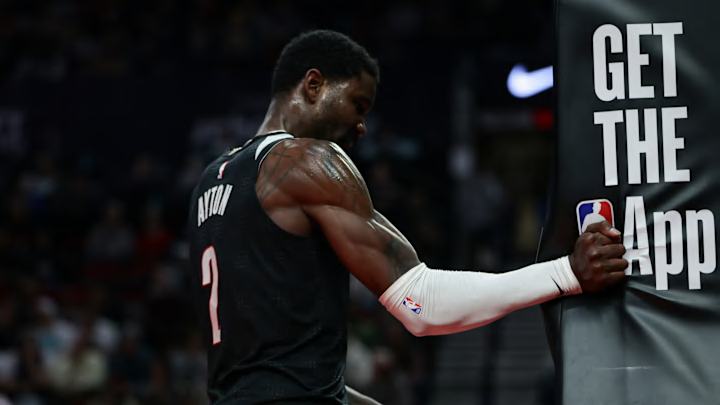From the second the Portland Trail Blazers selected Donovan Clingan with the No. 7 overall pick in the 2024 NBA Draft, it's been obvious that Deandre Ayton is the odd man out in Rip City.
One year later, it's only more apparent, as Clingan's rookie season proved he's the superior option as Portland's center of the future. He's younger, cheaper, and, most importantly, impacts winning at a higher level -- whether it's the physicality, rebounding, and rim protection or overlooked traits such as his basketball IQ and screen setting.
Deandre Ayton’s future in Portland is hanging by a thread
So, where does that leave Ayton? In a perfect world, the Blazers would trade him this summer.
The good news is that the likelihood of them finding a trade partner has increased since the February trade deadline. Teams will have more moving parts and financial flexibility this offseason to take on his $35.6 million contract, which shouldn't be as much of a deterrent since it expires after this season.
The bad news is it's still going to be incredibly challenging. Here's what Sean Highkin of Rose Garden Report wrote regarding Ayton's trade value this summer:
"I'm not sure how much demand there will be for him in the trade market outside of being a big expiring contract. Clingan will be the Blazers' long-term center, but I don't think they view keeping Ayton around in the short term as a negative."
More likely than not, Ayton will be on the Blazers' roster heading into the 2025-26 season, barring a blockbuster trade where he's used as a salary filler. That gives him one final audition to prove that he fits into Portland's long-term core. But, as of now, he's on the outside looking in.
Ayton needs to carve out a new role with the Blazers
Ayton's two seasons in Portland have been mediocre, with his production dipping since coming over from Phoenix. There are a few ways to get back on track in his third year.
First and foremost, Ayton needs to improve his inconsistent motor, as there were times when he simply lacked effort, which is a frustrating problem for your team's highest-paid player.
He also needs to become more available -- Ayton's played just 55 and 40 games in the past two seasons. But even then, it's hard to justify keeping Ayton around over Clingan.
The easiest way he could fit into this crowded Portland frontcourt beyond next season is by improving his three-point shooting.
There were talks of Chauncey Billups experimenting with a Twin Towers lineup of Ayton and Clingan. However, that didn't materialize, mainly because neither center proved to be the reliable shooter Portland had hoped for.
Ayton is a career 23 percent three-point shooter, connecting on just 18.8 percent of his attempts last season. His form and midrange shooting touch suggest he could significantly improve, but he still has a long way to go to reach the 35.1 percent mark centers had this season.
The playoffs have shown that having frontcourt size is extremely valuable, with double big lineups even coming back in style for certain teams like the Houston Rockets, Minnesota Timberwolves, Boston Celtics, and Cleveland Cavaliers. But there's a big difference between those teams' formulas and why it doesn't work as effectively for the Blazers with Ayton.
Steven Adams provides elite physicality. Naz Reid, Al Horford, and Kristaps Porziņģis all effectively space the floor. Evan Mobley is the Defensive Player of the Year. Playing these bigs leaves their teams vulnerable in some areas, but it works because they more than make up for it by punishing opponents elsewhere.
Ayton doesn't have that one standout trait to make teams pay. He needs to develop that to fit alongside Clingan. It's the only way he can fit into Portland's plans going forward. Otherwise, they'd be better off letting him test free agency after this season.
